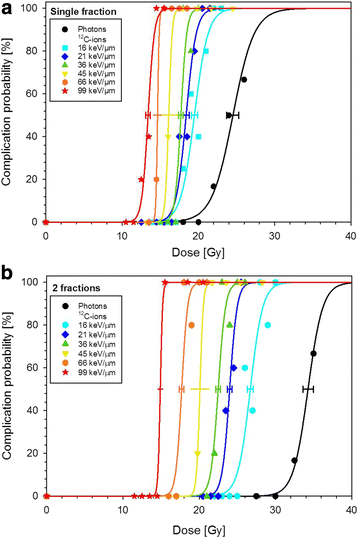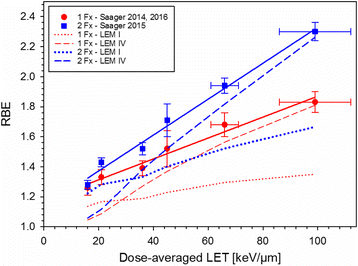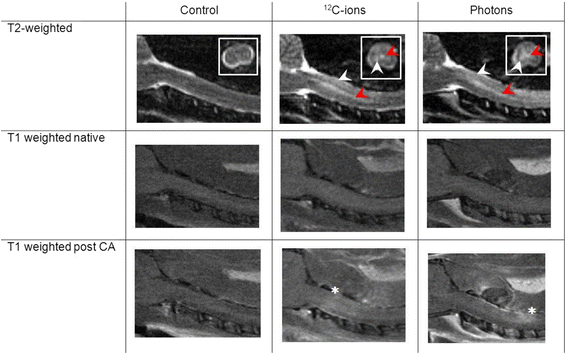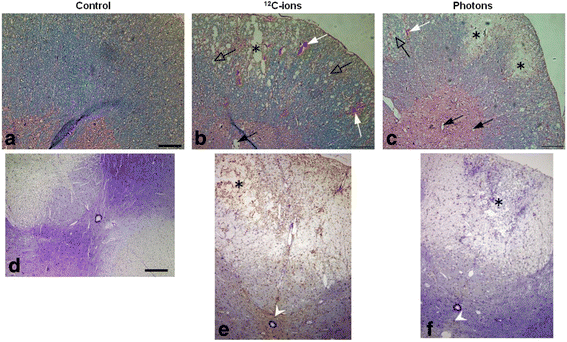Late normal tissue response in the rat spinal cord after carbon ion irradiation
- PMID: 29325596
- PMCID: PMC5765675
- DOI: 10.1186/s13014-017-0950-5
Late normal tissue response in the rat spinal cord after carbon ion irradiation
Abstract
Background: The present work summarizes the research activities on radiation-induced late effects in the rat spinal cord carried out within the "clinical research group ion beam therapy" funded by the German Research Foundation (DFG, KFO 214).
Methods and materials: Dose-response curves for the endpoint radiation-induced myelopathy were determined at 6 different positions (LET 16-99 keV/μm) within a 6 cm spread-out Bragg peak using either 1, 2 or 6 fractions of carbon ions. Based on the tolerance dose TD50 of carbon ions and photons, the relative biological effectiveness (RBE) was determined and compared with predictions of the local effect model (LEM I and IV). Within a longitudinal magnetic resonance imaging (MRI)-based study the temporal development of radiation-induced changes in the spinal cord was characterized. To test the protective potential of the ACE (angiotensin converting enzyme)-inhibitor ramipril™, an additional dose-response experiment was performed.
Results: The RBE-values increased with LET and the increase was found to be larger for smaller fractional doses. Benchmarking the RBE-values as predicted by LEM I and LEM IV with the measured data revealed that LEM IV is more accurate in the high-LET, while LEM I is more accurate in the low-LET region. Characterization of the temporal development of radiation-induced changes with MRI demonstrated a shorter latency time for carbon ions, reflected on the histological level by an increased vessel perforation after carbon ion as compared to photon irradiations. For the ACE-inhibitor ramipril™, a mitigative rather than protective effect was found.
Conclusions: This comprehensive study established a large and consistent RBE data base for late effects in the rat spinal cord after carbon ion irradiation which will be further extended in ongoing studies. Using MRI, an extensive characterization of the temporal development of radiation-induced alterations was obtained. The reduced latency time for carbon ions is expected to originate from a dynamic interaction of various complex pathological processes. A dominant observation after carbon ion irradiation was an increase in vessel perforation preferentially in the white matter. To enable a targeted pharmacological intervention more details of the molecular pathways, responsible for the development of radiation-induced myelopathy are required.
Keywords: Carbon ion therapy; Magnetic resonance imaging; Radiation induced myelopathy; Rat spinal cord; Relative biological effectiveness (RBE).
Conflict of interest statement
Ethics approval
All experiments were approved by the governmental review committee on animal care (35–9185.81/G62–08, G117/13, G34/13).
Consent for publication
Not applicable.
Competing interests
The authors declare that they have no competing interests.
Publisher’s Note
Springer Nature remains neutral with regard to jurisdictional claims in published maps and institutional affiliations.
Figures




Similar articles
-
Longitudinal MRI study after carbon ion and photon irradiation: shorter latency time for myelopathy is not associated with differential morphological changes.Radiat Oncol. 2021 Mar 31;16(1):63. doi: 10.1186/s13014-021-01792-8. Radiat Oncol. 2021. PMID: 33789720 Free PMC article.
-
Fractionated carbon ion irradiations of the rat spinal cord: comparison of the relative biological effectiveness with predictions of the local effect model.Radiat Oncol. 2020 Jan 3;15(1):6. doi: 10.1186/s13014-019-1439-1. Radiat Oncol. 2020. PMID: 31900185 Free PMC article.
-
Split dose carbon ion irradiation of the rat spinal cord: Dependence of the relative biological effectiveness on dose and linear energy transfer.Radiother Oncol. 2015 Nov;117(2):358-63. doi: 10.1016/j.radonc.2015.07.006. Epub 2015 Jul 18. Radiother Oncol. 2015. PMID: 26197953
-
Alternative models for estimating the radiotherapy retreatment dose for the spinal cord.Int J Radiat Biol. 2014 Sep;90(9):731-41. doi: 10.3109/09553002.2014.925151. Epub 2014 Jul 7. Int J Radiat Biol. 2014. PMID: 24894515 Review.
-
A comparison of mechanism-inspired models for particle relative biological effectiveness (RBE).Med Phys. 2018 Nov;45(11):e925-e952. doi: 10.1002/mp.13207. Med Phys. 2018. PMID: 30421808 Review.
Cited by
-
High-LET charged particles: radiobiology and application for new approaches in radiotherapy.Strahlenther Onkol. 2023 Dec;199(12):1225-1241. doi: 10.1007/s00066-023-02158-7. Epub 2023 Oct 23. Strahlenther Onkol. 2023. PMID: 37872399 Free PMC article. Review.
-
A DNA damage multiscale model for NTCP in proton and hadron therapy.Med Phys. 2020 Apr;47(4):2005-2012. doi: 10.1002/mp.14034. Epub 2020 Feb 10. Med Phys. 2020. PMID: 31955444 Free PMC article.
-
Evaluation of proton beam radiation-induced skin injury in a murine model using a clinical SOBP.PLoS One. 2020 May 22;15(5):e0233258. doi: 10.1371/journal.pone.0233258. eCollection 2020. PLoS One. 2020. PMID: 32442228 Free PMC article.
-
Longitudinal MRI study after carbon ion and photon irradiation: shorter latency time for myelopathy is not associated with differential morphological changes.Radiat Oncol. 2021 Mar 31;16(1):63. doi: 10.1186/s13014-021-01792-8. Radiat Oncol. 2021. PMID: 33789720 Free PMC article.
-
Carbon Ion Radiobiology.Cancers (Basel). 2020 Oct 17;12(10):3022. doi: 10.3390/cancers12103022. Cancers (Basel). 2020. PMID: 33080914 Free PMC article. Review.
References
-
- Uhl M, Herfarth K, Debus J. Comparing the use of protons and carbon ions for treatment. Cancer J. 2014;20(6):433–439. - PubMed
-
- Jensen AD, Nikoghosyan AV, Poulakis M, et al. Combined intensity-modulated radiotherapy plus raster-scanned carbon ion boost for advanced adenoid cystic carcinoma of the head and neck results in superior locoregional control and overall survival. Cancer. 2015;121(17):3001–3009. - PubMed
-
- Uhl M, Mattke M, Welzel T, et al. High control rate in patients with chondrosarcoma of the skull base after carbon ion therapy: first report of long-term results. Cancer. 2014;120(10):1579–1585. - PubMed
-
- Uhl M, Mattke M, Welzel T, et al. Highly effective treatment of skull base chordoma with carbon ion irradiation using a raster scan technique in 155 patients: first long-term results. Cancer. 2014;120(21):3410–3417. - PubMed
MeSH terms
Substances
Grants and funding
LinkOut - more resources
Full Text Sources
Other Literature Sources
Miscellaneous

